The first date, dinner party, celebration of an important date in a close family circle - all this is an excellent occasion to organize a feast in a memorable place. Any trip to the restaurant is a special event and is accompanied by the selection of the appropriate image in the wardrobe. Stylishly selected clothes, neat make-up and accessories will remain unappreciated if loved ones who intend to share an important meal with you are not familiar with the basic rules of etiquette.


Features
The basics of restaurant service and etiquette have their own distinctive features and seemingly insignificant little things that make up the general impression of the evening. Simple rules begin to apply long before the meeting, for example, it has long been believed that a table in a restaurant should be booked by a man, and if possible it should come to the meeting place a little earlier than the girl.
The first person to enter the institution is also a man, if the evening is held in the company of guests, then according to all the rules, the one who initiated the meeting “leads”, also initially confirming its subsequent consent to payment.
This rule may partially lose its relevance, but it still works during social and business meetings of company leaders and dinner parties during negotiations.
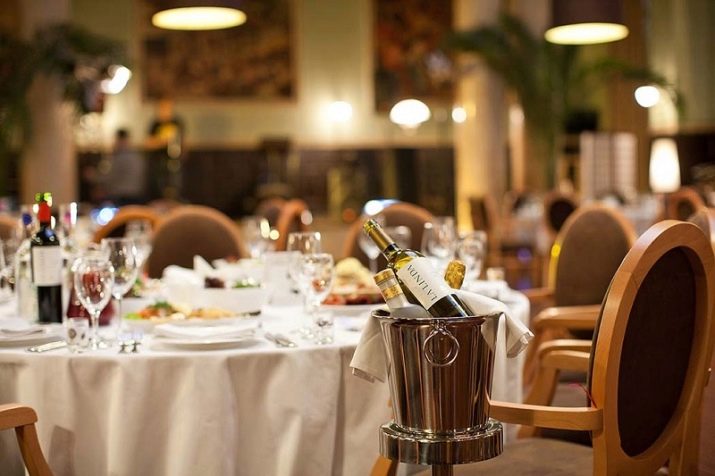
Visitors at the very entrance by all rules are met by the administrator, also called head waiter, or the restaurant’s main waiter. The meeting involves greeting and reconciling the armor of the table. If you have a wardrobe, you should leave your outerwear there, as well as purchases or, for example, a work portfolio. A man always helps a woman undress, offering a helping hand.
Landing is as follows: a man always gives a woman a more profitable landing place, for example, with a view through a window or onto the stage, if the evening involves musical accompaniment. Pushing one of the chairs, he invites the lady to sit down. Having settled down at the reserved table and having studied the presented menu, you need to place an order.
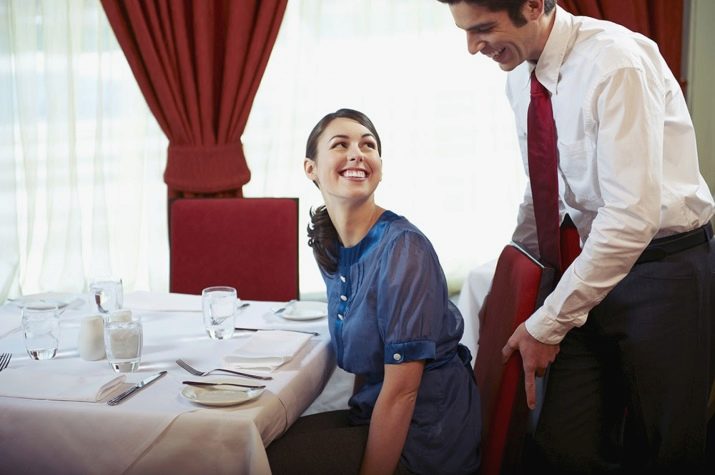
At this point, you need to properly call the waiter. Any way to attract attention through all kinds of sounds is considered to be very ignorant: tapping cutlery on a table or dishes, trying to call out. In such a situation, a simple gesture is enough - a wave of the hand or a nod of the head, accompanied by direct contact with the eyes of the staff. The most correct option would be to contact any representative of the service personnel directly by name, which is always written on a badge attached to the form.
The opportunity to be the first to complete the order of a meal is always given to a guest or a girl, while men follow in their choice of alcoholic beverages, they trust him to the male gender. In principle, the initial distribution of the menu is as follows: the main one is for the female half, the bar card is male.
Try to order the same number of dishes as your companion.



How to behave at the table?
The rules of etiquette in a restaurant suggest the absence of unnecessary things on the surface of the table. Thus, it is considered very ignorant to lay out the phone, keys, wallet or any clothing accessories on the table. A particularly gross mistake is to put a bag on the table. This is not only ignorant of your interlocutor or company, but also distracts the waiter and other staff of the establishment.
Sitting at your table, remember the posture: with a proper fit, there will be no desire to put your elbows on the table or bend over it again. Knees are best covered with a napkin prepared when laying the table. If you need to leave while eating, the napkin is put on your seat.
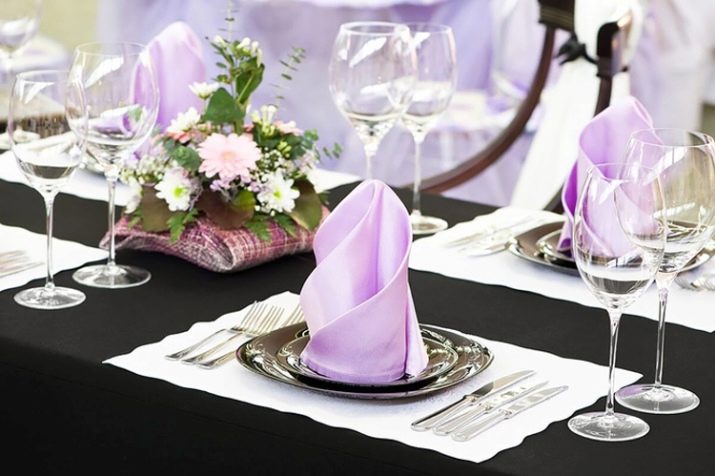
While waiting for the order, it's time for a small conversation, but loud conversations violate the right atmosphere for eating, so in restaurant establishments it is customary to communicate with partners quietly. Vivid stories, rich gestures, as well as loud peals of laughter are also an indicator of impoliteness.
The waiter brings dishes to the serving table as they are ready, but they should only start eating when each of your company has a meal or common snacks.


The basic rules of behavior during meals entail 8 simple steps:
- Do not blow on hot food, wait for the dish to cool.
- Observe the correct position at the table. Do not put your elbows on the table, hold your posture, do not hide your hands under the table, and do not bend too low above the plate.
- Do not spit out the bones. Spitting out fruit, fish or other bones in the palm of your hand or a napkin is considered impolite, try to get the bones with a fork. A more neutral option seems to be shifting the bone into a napkin placed in the mouth.

- Do not eat from someone else's plate, and especially cutlery. The romance of movie scenes turns out to be a very ignorant violation of table behavior
- Do not talk with your mouth full, try not to slurp or make any other sounds that give any appreciation to the cooked dishes.
- Do not use personal appliances while laying on some common dish.
- Correctly cut one piece from the cooked dish, only after eating it, cut off the next. Do not cut the cooked dish whole, the constant picking in the plate looks ridiculous.
- To avoid incidents and for greater confidence, try to wipe your hands as often as possible and pat your mouth with a napkin.

How to use devices?
The most common fear of anyone who gets to a dinner party in a good restaurant for the first time is the inability to cope with the amount of cutlery, and the fear of looking silly. In fact, there is always logic in everything, and a table set in advance can be read.
First served snacks. The very small diameter of the plate will tell you which first spoon or small snack fork is best to use. Cutlery laid out in a strict order of serving.
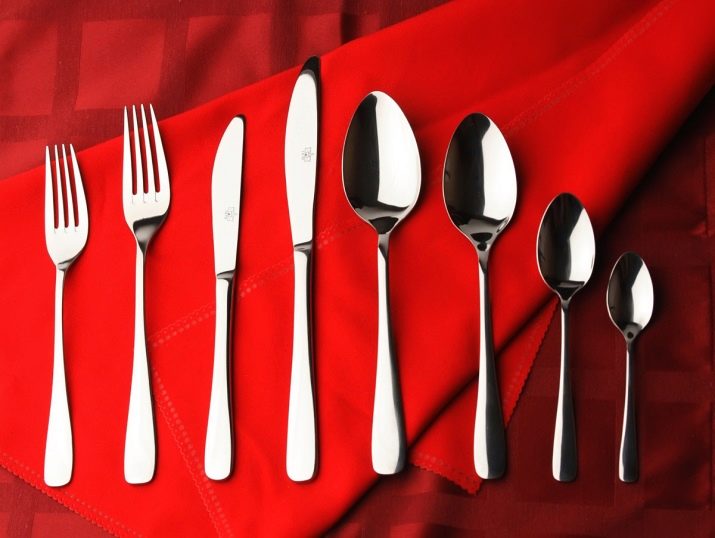
First and second courses are served next, the devices also most often correspond to the diameter of the plate, and all subsequent ones do not differ much. If today you do not eat soup, then a tablespoon of deep spoon will remain in the same place, and at a certain time when the dish changes, the waiter will pick it up.
Special are the devices for fish dishes: a special shape of a knife resembling a scapula (which is especially convenient when cutting and separating bones) and a fork with shorter cloves.
Before serving the dessert, the appliances must be changed again. The dessert fork has three cloves, and each of the devices is different in size.
Desserts are also served for fruits, because taking food with your hands is considered indecent.
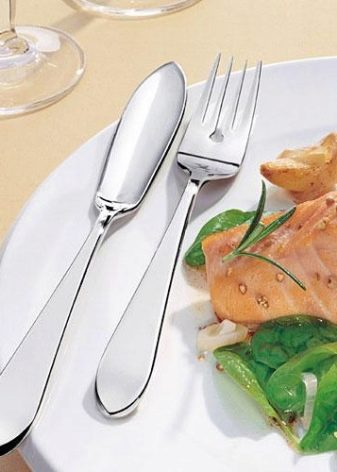

It’s not enough to figure out which device and what to eat and cut, it’s also important to do it right. For example, the knife should always be held in the right hand. If you’re not used to eating with a knife, then make it a habit to practice this simple skill at home in separate meals. The spoon, as a rule, is not filled completely, so as not to spill the contents.
The position of the devices on the table is the opportunity to maintain a dialogue with the staff of the institution. For example, if during a meal there was a need to leave, but you intend to continue the dish, it is customary to put the devices in such a way that their ends are in contact, and if you are finished with the dish, then the devices are placed parallel to each other.
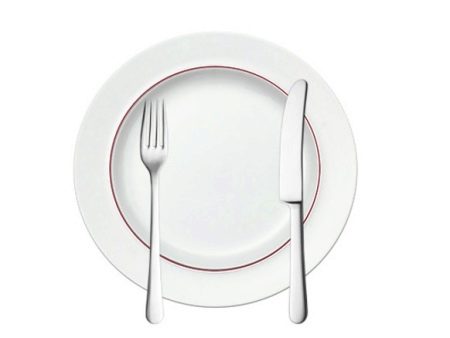
There are also other little things that can even tell you if you liked a particular dish. Having crossed the devices so that the knife falls between the cloves of the fork, you can tell that you didn’t like the dish according to your taste or other characteristics, and to tell the opposite and please the waiters and cooks, place the devices perpendicular to the side of the table and point the tip to the right.

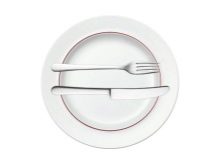
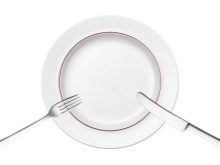
After eating, wipe your mouth and hands with a napkin that you can put on the dish, and place the cutlery parallel with each other with the handles down, so that you show that the meal is finished, and the waiter can clean the table or continue serving, serving the next dish.
Simple combinations can be an excellent compliment for staff or a signal, which is worth paying attention to.
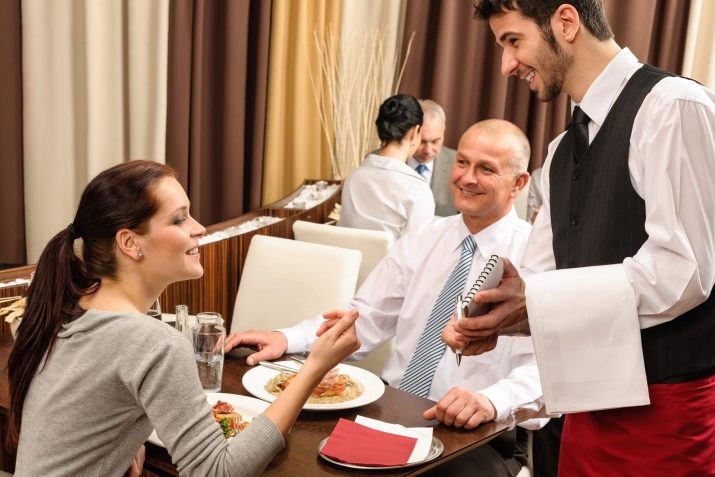
Tips & Tricks
Often a contentious issue arises after eating, if necessary, to pay the bill. Restaurant etiquette assumes that the invoice is paid by the inviting person or the man. Dividing the bill is appropriate if the dinner or any other meal was friendly. In restaurants it is customary to tip, a pleasant compliment for the staff will be ten percent added to the total bill.

In fashionable establishments, as a rule, in addition to the waiter and the administrator of the hall, the staff also has to interact with the sommelier. Rarely enjoyable dinner without a bottle of good wine.
It is considered impolite to open the wine yourself, entrust the serving to a professional as well.
A true sommelier, an enthusiastic master of his craft, is always ready to answer any questions about alcoholic drinks and tell the story of the origin of a particular variety.
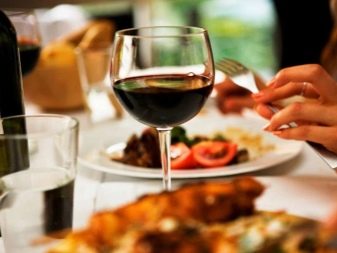

Many are used to thinking that special etiquette rules apply to fashionable restaurant establishments, but this is far from the case. Any polite gentleman or lady will not allow herself to behave outside the culture of public institutions.Even a Sunday family breakfast in a cozy coffee shop or a business lunch in a cafe requires compliance with norms and knowledge of the basic principles of etiquette.
After a long pleasant meal and a paid bill The initiator of leaving the restaurant, of course, is also a man.
Knowing the basic rules of etiquette will help you relax as much as possible and have a good time at a meal in good company.
It is enough for girls to know only fifteen rules of restaurant etiquette in order to make a good impression on their man and others when they visit the institution. You can find out about them in the next video.






